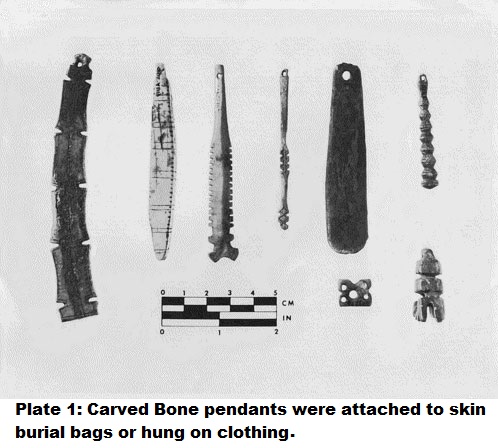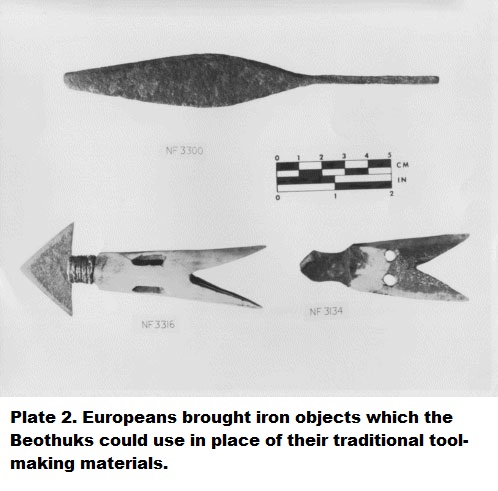The Beothuks
Museum Notes - The Beothuks
By Ralph T. Pastore
Archaeology Unit, Memorial University of Newfoundland.
Revised edition, Fall 1991
[Originally published in printed form.]
At present we cannot be absolutely certain of the origins of the Beothuk Indians, but it seems likely that they were the descendants of the Maritime Archaic people of Newfoundland and Labrador. We can trace the ancestors of the Beothuks back to about 1000 years ago on the island of Newfoundland, but before that the picture is not clear. The Maritime Archaic Indians appear to have died out in Newfoundland about 3200 years B.P. (before present), and their place on the island was taken by two groups of palaeoeskimos. The first of these, those belonging to the Groswater culture, occupied Newfoundland from ca. 2600 B.P. to about 2100 B.P. They were replaced by the Dorset Eskimo whose sites on the island have been dated from about 1900 B.P. to perhaps as late as 1,200 B.P. During the last years of this Dorset occupation archaeologists have found traces of an Indian population which we believe to be ancestral to that of the Beothuks. At present, it seems most likely that these prehistoric Beothuks were descended from a Maritime Archaic population in southern Labrador, although it is conceivable that a small, remnant Maritime Archaic population, perhaps reinforced by migrants from Labrador, remained on the island and eventually became the historic Beothuks.
It is now possible to trace the prehistoric ancestors of the historically-known Beothuks back to a people who produced stone tools assigned to what archaeologists call the Beaches Complex (dated to ca. 1000 B.P.) and the Little Passage Complex which succeeded it and lasted until the arrival of Europeans. In fact, there is a relatively smooth transition in the styles of stone tools produced by the Little Passage people and the Beothuks. With European contact the island's inhabitants began to acquire iron tools, and the practise is refer to these people as Beothuks.
The Beothuks appear to have spoken a variant of the Algonkian family of languages, and it is possible that the modern language closest to Beothuk is that spoken by the Innu (Naskapi- Montagnais) of Quebec-Labrador. In fact, the Beothuks were simply one end of a continuum of peoples that extended from the island of Newfoundland to the northern portion of the Quebec-Labrador Peninsula. Within that continuum there appears to have been trade in materials such as stone from which tools were made, and there may even have been an exchange in marriage partners. Thus, in the prehistoric period, at least, while there may have been significant differences between peoples at the extreme ends of this spectrum, it may be meaningless, for example, to differentiate between the Native Peoples of Newfoundland's Northern Peninsula and those immediately on the other side of the Strait of Belle Isle.
Although there were strong similiarities between the Native People of Newfoundland and those of the neighboring Quebec-Labrador coast, the nature of the Newfoundland environment resulted in a somewhat different way of life than on the mainland. One of the major differences between life on the island and the mainland was the relative lack of land animals upon which Newfoundland's Native Peoples could prey. Unlike the mainland, the island lacked moose, porcupine, and varying hare. This meant that the only major land animals available for Newfoundland's Native hunters were caribou and beaver -- and beaver stocks were significantly smaller than those on the mainland. As a result, the Beothuks and their predecessors were dependent upon the resources of the sea and the coast -- the seals, capelin, smelt, sea birds, and many other species. Such resources, including caribou, are usually available in large numbers at the same time each year. However, we know that at times caribou herds, because of the weather or biting insects, for example, do not follow their accustomed migratory route. Similarly, with harp seals, there have been occasions when, because of poor ice or adverse wind conditions, the huge harp seal herds have been inaccessible to land-based hunters. When this happened, the island's hunting peoples would have been hard pressed to find alternate sources of food. If one or more of the major species upon which prehistoric Native Peoples depended were unavailable for more than a year, the result might be the sort extinction that we seem to see in the archaeological record.
Thus the Beothuks had to live within an ecological system that was more vulnerable than that of the mainland. The arrival of Europeans at the beginning of the 16th century may, in fact, have made life somewhat easier for the Beothuks, for Europeans brought iron objects with them which the Beothuks could use in place of their traditional materials. Originally, lances, arrows and harpoons, for example, would have been tipped with bone or stone, but eventually the Beothuks substituted iron for these traditional materials.
These weapons were used to take the creatures of the sea and land for food and clothing. At present we cannot be completely sure of the seasonal round followed by the Beothuks in the pursuit of these animals. The most likely pattern may have involved spending most of the year along the coasts where they lived largely upon fish, seals, sea birds, eggs, shellfish, and the like. In the fall, when the caribou migrated between their summer and winter grounds, the Beothuks carried out a major hunt, probably killing most of their prey as the animals crossed narrow bodies of water. The specific settlement and subsistence patterns, however, may well have varied over time and space. In some areas, for example, a local band may have occupied a village on the coast for the entire year, only sending hunting parties a short distance inland in the fall. In other areas the whole community may have spent the warmer months on the coast and the colder portion of the year in the interior.
Depending upon the weather, the Beothuks wore a caribou-skin mantle with mocassins, leggings, mittens, and arm-coverings, any of which could be discarded as it grew warmer. Skins as well as bark were also used to make a variety of well-made containers. The Beothuks also had a well-developed technology of travel. When deep snow covered the ground they used snowshoes; when the ice left the waters of the coasts and the interior, the Beothuks employed a variety of canoes, some of which were capable of making considerable trips across the open sea. Beothuk housing also appears to have been quite variable. Their prehistoric ancestors seem to have constructed only lightly-built temporary structures, perhaps resembling the conical wigwams built of a framework of saplings covered with sheets of bark that we know that the historic Beothuks used. Archaeological evidence from the late 17th/early 18th century indicates that the Beothuks also made somewhat more substantial structures, one of which was constructed by digging a shallow depression, erecting a conical wigwam in the middle and piling the excavated earth around the perimeter. Another house form from that period was a multi-sided wigwam, about 6 metres in diameter, built of short vertical poles upon which were laid stringers from which rafters extended to meet in the centre. It too was built in an excavated depression with an earthen ring banked around the walls. The final form known from this period was an oval structure measuring about 10 m by 4 m. The historical record from the late 18th and early 19th centuries suggests that the Beothuks who had been forced into taking refuge along the Exploits River were building even more substantial dwellings, constructed along the same lines as the earlier houses but built of logs rather than poles. European observers also reported that the Beothuks built a variety of storehouses, some of which looked like European structures.
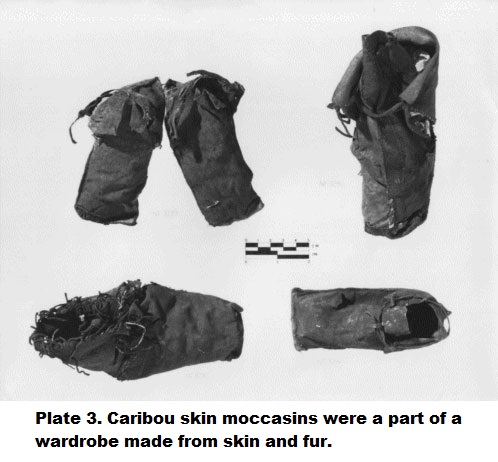 We know much more about Beothuk technology than we do about the organization of their society and their religious beliefs. We don't even know how many Beothuks there were at the time of European contact. No serious student of the subject has suggested that they numbered more than 2,000 and most estimates are half that number or less. Our lack of knowledge about the Beothuks is due to the fact that for a number of reasons, the sorts of European observers -- Indian agents, missionaries, and fur traders -- who have provided us with information about other Native Peoples, were absent in Newfoundland. The absence of such European observers is directly related to the nature of the Newfoundland economy. From its discovery by Europeans until well into the 18th century, Newfoundland was primarily a base for a European migratory fishery. Those fishermen who carried out a "dry" fishery came to the island in spring and erected wharves, flakes and stages along the shore. When they departed in late summer/early fall, they often left behind the debris of such a fishery -- lost fish hooks, pieces of scrap metal, and especially nails. Archaeologists have recovered hundreds of these nails that the Beothuks had pilfered and modified into projectile points and perhaps other tools. This meant that the Beothuks, unlike most other North American Native groups, did not need to trade with Europeans for the edged metal tools that were so desired by all other New World peoples. The Beothuk decision not to trade with Europeans made perfect sense because such a trade was often disruptive to Native Peoples. It sometimes involved radical shifts in the traditional seasonal round, dangerous encounters with sometimes hostile Europeans, and exposure to disease and alcohol.
We know much more about Beothuk technology than we do about the organization of their society and their religious beliefs. We don't even know how many Beothuks there were at the time of European contact. No serious student of the subject has suggested that they numbered more than 2,000 and most estimates are half that number or less. Our lack of knowledge about the Beothuks is due to the fact that for a number of reasons, the sorts of European observers -- Indian agents, missionaries, and fur traders -- who have provided us with information about other Native Peoples, were absent in Newfoundland. The absence of such European observers is directly related to the nature of the Newfoundland economy. From its discovery by Europeans until well into the 18th century, Newfoundland was primarily a base for a European migratory fishery. Those fishermen who carried out a "dry" fishery came to the island in spring and erected wharves, flakes and stages along the shore. When they departed in late summer/early fall, they often left behind the debris of such a fishery -- lost fish hooks, pieces of scrap metal, and especially nails. Archaeologists have recovered hundreds of these nails that the Beothuks had pilfered and modified into projectile points and perhaps other tools. This meant that the Beothuks, unlike most other North American Native groups, did not need to trade with Europeans for the edged metal tools that were so desired by all other New World peoples. The Beothuk decision not to trade with Europeans made perfect sense because such a trade was often disruptive to Native Peoples. It sometimes involved radical shifts in the traditional seasonal round, dangerous encounters with sometimes hostile Europeans, and exposure to disease and alcohol.
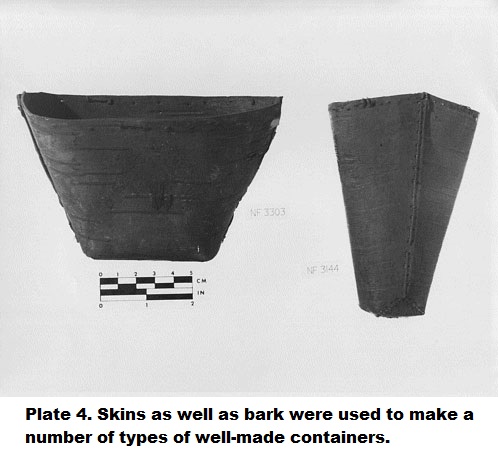 This helps to explain why, after the English would-be colonist, John Guy, had a friendly encounter with Beothuks in Trinity Bay in 1612, over 150 years would pass with very little mention of the Beothuks in the historical record. That would change after about the middle of the 18th century. By that time English permanent settlement, which had begun on the Avalon Peninsula, had spread to Trinity Bay, Bonavista Bay, and Notre Dame Bay. In addition, a growing Micmac presence in the southern third of the main part of the island had restricted Beothuk activity here. Inuit in the Strait of Belle Isle may also have prevented the Beothuks from exploiting the resources of that region. Most important, however, were the English communities which made it much more difficult for the Beothuks to get access to the vitally-needed resources of the coast. Increasingly, the Beothuks were forced to try to live on the inadequate resources of the interior. This proved impossible, and the last known Beothuk, Shanawdithit, died in 1829.
This helps to explain why, after the English would-be colonist, John Guy, had a friendly encounter with Beothuks in Trinity Bay in 1612, over 150 years would pass with very little mention of the Beothuks in the historical record. That would change after about the middle of the 18th century. By that time English permanent settlement, which had begun on the Avalon Peninsula, had spread to Trinity Bay, Bonavista Bay, and Notre Dame Bay. In addition, a growing Micmac presence in the southern third of the main part of the island had restricted Beothuk activity here. Inuit in the Strait of Belle Isle may also have prevented the Beothuks from exploiting the resources of that region. Most important, however, were the English communities which made it much more difficult for the Beothuks to get access to the vitally-needed resources of the coast. Increasingly, the Beothuks were forced to try to live on the inadequate resources of the interior. This proved impossible, and the last known Beothuk, Shanawdithit, died in 1829.
The tragic story of the Beothuks has attracted a great deal of sensationalist attention, but it is now clear that the extinction of these people was not a simple matter of the killing of Beothuks by brutal settlers and fishermen. Although it is true that some Beothuks were killed by Europeans who resented Beothuk thefts, this was not the major cause of their demise. Their loss of access to the seals, fish, birds and shellfish of the coasts was a much more significant factor. Given the Beothuk pattern of avoiding Europeans, it is also likely that there was relatively little danger of infection from European disease until perhaps relatively late in the history of the Beothuks when contacts with outsiders were more frequent. By that time, however, the pattern of Beothuk history was already set.
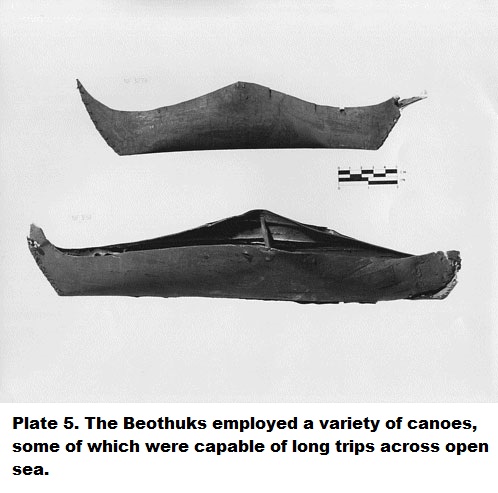 It has also sometimes been alleged that the French brought Micmacs to Newfoundland and offered them bounties for Beothuk heads. Micmacs from Cape Breton had been coming to Newfoundland from at least the beginning of the 17th century, but they had come for their own reasons -- to hunt, fish and trap from St. George's Bay to Placentia Bay -- not at the behest of the French. More importantly, there is no concrete evidence of French payment of bounties to the Micmacs for killing Beothuks. There may have been occasional clashes between the Beothuks and the Micmacs, but the real danger posed by the Micmacs was similar to that posed by Europeans on the island. Both the Micmacs and the Europeans were in competition with the Beothuks for the island's limited resources. Reduced in numbers, relatively poorly-armed, and lacking in allies, it is perhaps not surprising that the Beothuks ultimately suffered the same fate as the earlier, prehistoric peoples who once lived in Newfoundland.
It has also sometimes been alleged that the French brought Micmacs to Newfoundland and offered them bounties for Beothuk heads. Micmacs from Cape Breton had been coming to Newfoundland from at least the beginning of the 17th century, but they had come for their own reasons -- to hunt, fish and trap from St. George's Bay to Placentia Bay -- not at the behest of the French. More importantly, there is no concrete evidence of French payment of bounties to the Micmacs for killing Beothuks. There may have been occasional clashes between the Beothuks and the Micmacs, but the real danger posed by the Micmacs was similar to that posed by Europeans on the island. Both the Micmacs and the Europeans were in competition with the Beothuks for the island's limited resources. Reduced in numbers, relatively poorly-armed, and lacking in allies, it is perhaps not surprising that the Beothuks ultimately suffered the same fate as the earlier, prehistoric peoples who once lived in Newfoundland.

